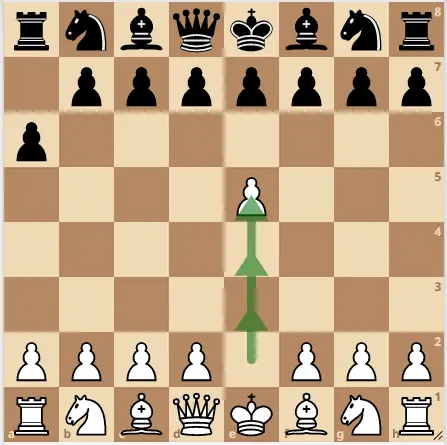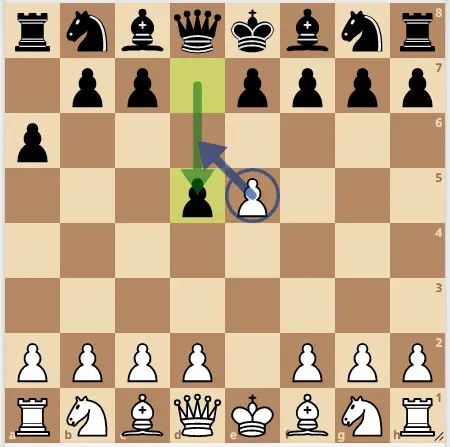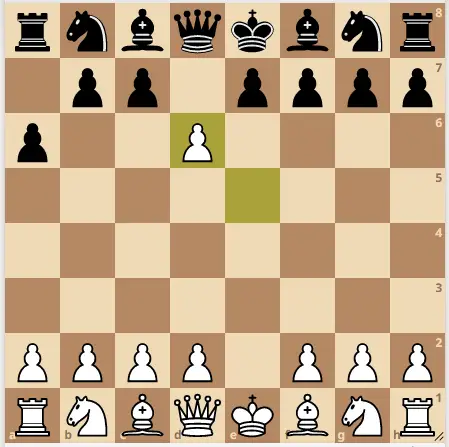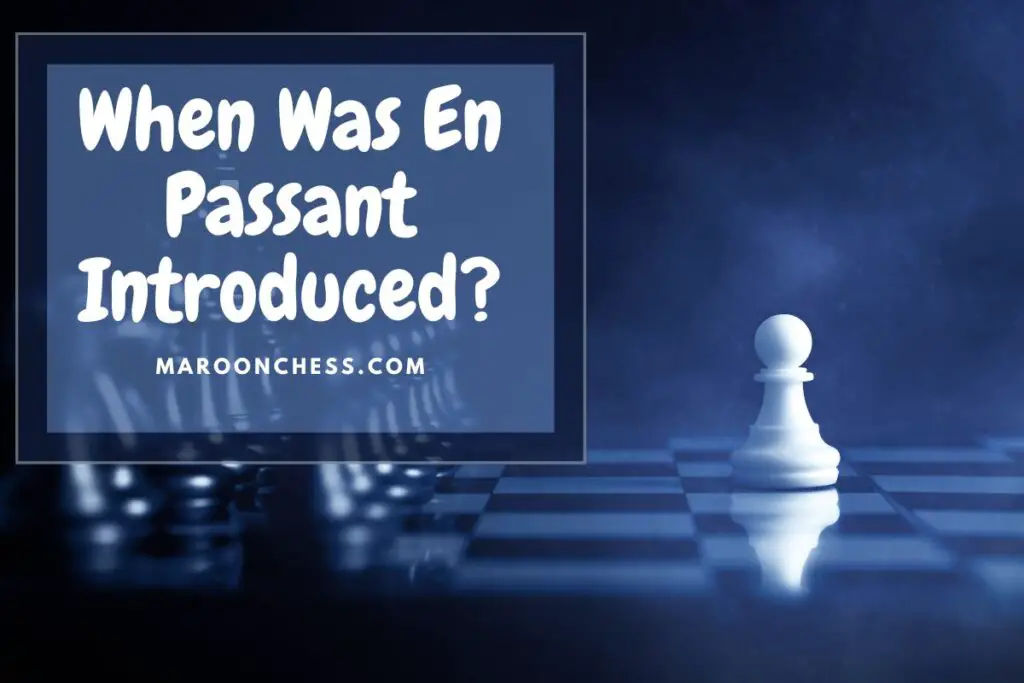Chess is a game that has evolved quite nicely over the centuries. There have been many moves added to the game from castling, pawn promotion, to the 2 square pawn advance. However, one move that has sparked the interest of many beginner players is en passant.
At first glance, this may seem like a strange move. A pawn capturing a pawn beside it?
However, there is a deeper reason why this move exist after closer inspection. In this article, we will discuss when was the move “en passant” introduced to the game of chess and why it was introduced. Read along to find out the answers.
When Was En Passant Introduced?
The en passant move in chess has been around for quite some time. Sources state that the move was first invented in the year 1561 but didn’t get officially accepted in the FIDE rule book until the year 1880.
Before 1880, some European countries such as Italy did not adopt the en passant rule. This exclusion was known as passar battaglia. It wasn’t until they had the 1881 Milan tournament that Italy finally decided to accept the en passant rule in preparation for this tournament.
By 1881, every single country had fully adopted the en passant rule and it was one of the last major additions to European chess.
Indeed, en passant was the last major rule added to the books, making the game of chess more refined.
Even with moves like castling, pawn promotion and the 2 pawn advance, the game of chess was still not complete without the en passant move. So why is this the case? Why was en passant introduced in the rules of chess?
Here are the 2 major reasons why FIDE and the U.S.C.F bodies decided to introduce en passant in the game of chess:
Why Was En Passant Introduced?
En passant was introduced to:
- Stop the position from locking up
- Prevent a pawn from evading capture on its first move
Stop the position from locking up
Locked or closed positions tend to stop players from making progress over the board. When the position is locked up for both sides, their pieces are not able to move freely nor are they able to generate a feasible plan for their pieces.
When this happens, there is no progress to be made and the game will probably end in a draw. To stop this from happening, en passant was introduced to prevent the position from locking up.
Through en passant, you ensure that the position remains opened for your pieces. This reduces the chance of the game ending in a draw and it makes for a more interesting game.
Prevent a pawn from evading capture on its first move
Back in the older days of chess, the pawns could only advance one square on their first move. However, it was thought that this move was too slow as the pawn would have to make 2 moves to reach the central squares of the chess board.
Time is an important factor in chess as the pieces need to be developed quickly. As a result, the pawns were granted with the ability to move 2 squares forward on their first move in order to speed up things in the opening phase of the game.
However, upon introducing the 2 pawn move, the rule makers noticed that the pawn from its initial position could move 2 squares forward and bypass a pawn that is on the 5 th rank (4th rank for black).
It wouldn’t be appropriate or fair if a pawn could simply evade capture in such a manner. Therefore, the rule en passant was created to stop this from happening.
Of course, a player do have the choice to determine whether or not he wants to en passant. But he should know that this move is only legal on the move following the advance. This means en passant can only be done immediately and is illegal on any other move after that.
How Does One En Passant In Chess?
Now that we got the history of en passant out of the way, it’s time that you master this strange looking move once and for all! The conditions for en passant are as follow:
En passant is only possible if your pawn is on the 5th rank for white or the 4th rank for black. In other words, your pawn must have advanced 3 squares forward from its initial position.
The pawn must advance 3 squares forward for en passant to be made possible

If your opponent advances his pawn 2 squares forward from its starting position and it lands beside your pawn, you can capture that pawn diagonally forward on the square that the enemy pawn passed over as if it had only moved one square from its initial position.

In the position above, white can capture the black pawn via exd6 e.p as though the latter had been moved only one square. This move can only be done following black’s advance of the d pawn.
After en passant

As you can see from the diagram above, black did not succeed in evading capture. Due to en passant rule, white was able to capture black’s pawn even though black’s pawn was NOT diagonally left or right of white’s pawn. En passant is the only time a pawn can capture a pawn beside it.
Pros And Cons Of En Passant
While en passant does help to prevent the positiion from locking up and prevent a pawn from evading capture, there are also some downsides to this move depending on the nature of the position.
En Passant When Your King Is Uncastled
You may want to think twice before en passant whenever your king is still in the center. Whenever you en passant, you are opening lines not just for your pieces, but for your opponent’s pieces as well. It would not be wise to en passant in the center of the board and open up the position if your king is still uncastled.
Your opponent can use his pieces to attack your king along the e-file if this file should get opened up as a result of en passant. Therefore, it’s highly recommended that you castle your king before opening up the position with a move like en passant. Unless your opponent is behind in development, it is dangerous to en passant when your king is uncastled.
En Passant Helps Develop Your Opponent’s Pieces
En passant can help develop your opponent’s piece more quickly and can resolve opening issues that your opponent could not have resolved himself. Therefore, you should always contemplate whether or not this move is actually more useful for your opponent.
Remember the principle of actiivity doesn’t only apply to your own pieces. The principle of activity states that you should activate your own pieces while also limiting the activity of your opponent’s pieces. Therefore, you should avoid a move like en passant if it helps activates your opponent’s pieces.
Where Is En Passant Outlined In The Rule Book?
En passant was added to the rule book in 1880. You can find en passant in article 3.7 (d) of the FIDE laws of chess rule book.
It quotes: “A pawn attacking a square crossed by an opponent’s pawn which has advanced two squares in one move from its original square may capture this opponent’s pawn as though the latter had been moved only one square. This capture is only legal on the move following this advance and is called an ‘en passant’ capture.”
FIDE is not the only jurisdiction in chess. There are other large governing bodies of chess such as the United States Chess Federation. While most of the chess rules are the same for FIDE and U.S.C.F, there are still a few rules that show different view points.
For example, the touch move rule is more strict under the FIDE laws of chess than the USCF rules. If you are in the United States, players can use both their hands to castle and still not get penalized as evident with the match between Hikaru Nakamura and Ian Nepomniachtchi at the 2015 Baku World Cup Armageddon game.
As it relates to en passant, the rules are the same among all known chess federations and is consistent throughout every country. The rules for en passant under the USCF is outlined in article 8F5 and 7C. The rule is pretty much the same as article 3.7d of the FIDE laws of chess.
Sources:
USCF chess rule book
Final Verdict
En passant is roughly 460 years old and will continue to be applied in standard chess. Though some may disagree with this move, it is still an effective move that adds balance to the game of chess. Without it, the game would be closed and drawish.
As a beginner, it’s important that you master this move if you wish to competitively compete in tournament events. En passant can come at a surprise if you don’t know this move. The players who wouldn’t know the rule are casual (non tournament) players or beginner level tournament players, typically young children.
Nevertheless, you should make sure that you learn this move so that it won’t come at a surprise whenever you are competing in tournaments.
For more related articles on en passant see:


